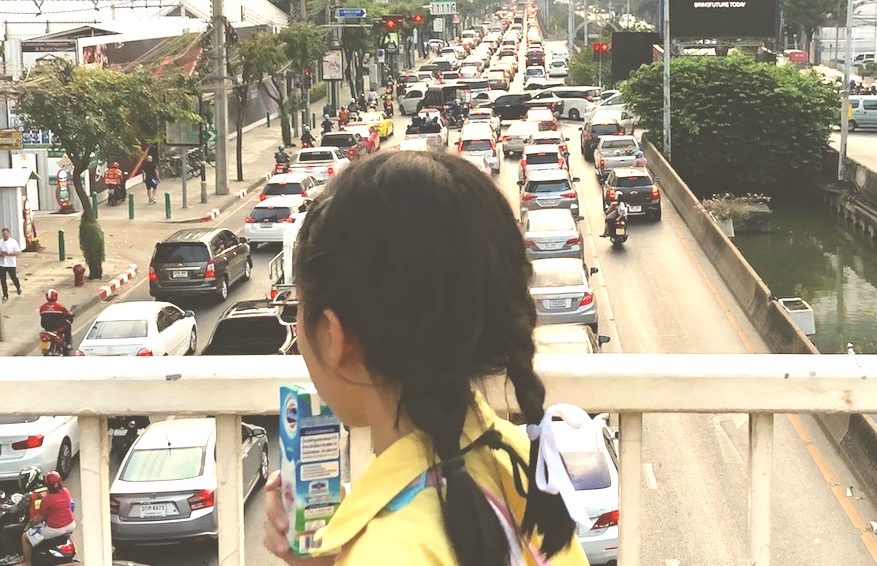The effects of air pollution on young children

The body and brain of young children are especially vulnerable to PM2.5 and other air pollutants. This is because their lungs are still growing, and they tend to be very active and inhale a great deal of air.
Why are children at high risk?
One reason children are particularly vulnerable to air pollution is that they breathe more rapidly than adults and absorb more pollutants. But there are other reasons:
- The largest portion of a child’s lungs will grow long after birth. Eighty percent of their tiny air sacs develop after birth. Those sacs, called alveoli, are where the life-sustaining transfer of oxygen to the blood takes place
- Children don’t behave like adults. They are often outside for longer periods and are usually more active when outdoors. Consequently, they inhale more polluted outdoor air than adults do
- Air pollution can also affect your child indirectly. Pregnant women who are exposed to polluted air, for example, are more likely to give birth prematurely and have small, low birth-weight children
Why are fine particles so dangerous for children?
- Fine dust (PM 2.5) affects the neurodevelopment of your child, negatively affecting mental and motor development
- High levels of air pollution directly affect a child’s measured levels of intelligence (IQ), equivalent to missing an entire year in school
- Even low levels of air pollution are damaging children’s lung function and can lead to chronic lung problems, asthma, and cardiovascular diseases later in life
- Air pollution is one of the leading threats to child health, according to the World Health Organization, accounting for almost 1 in 10 deaths in children under five years of age
How to protect Your Child while at home?
Even if it feels safe and clean, remember that small particles are invisible and can easily enter your house. Here are ways to protect Your Child inside the house:
- Close the windows on days where the pollution is high
- Get an air purifier with a HEPA filter. Ideally, get one for the bedroom and the play or living area
- If you have air conditioners, note that they usually don’t filter the small dangerous particles
- If you live next to a major road, be aware that even when air quality forecasts are good, vehicles on big roads can create high pollution levels up to 250 meters away and hence affect the air quality at your home
How to protect your Your Child in the car:
Children are also at risk of dangerous levels of air pollution inside your car because of the toxic air from the traffic around which cars don’t filter properly:
- If you must drive in traffic, set your air vent to recirculate with your windows up just before you hit the traffic on the road. But also try to keep a safe distance from vehicles ahead of you, especially diesel trucks or obviously polluting cars
- Install a HEPA-rated cabin air filter in your vehicle. If your car already has a HEPA filter preinstalled, make sure you change it regularly
- In addition, you can buy air purifiers for your car. Car air purifiers employ a range of technologies to improve the quality of air inside vehicles without any modification to your car
How to protect Your Child while outdoors:
- Protect Your Child by reducing the time spent outdoors when pollution is high
- If you take yYour Child for a walk around the city, then you should avoid high traffic streets
- If you cannot avoid polluted streets, get Your Child to wear a mask. We recommend the N95 Mask which is available for children or otherwise can be modified for children
What air level is safe for Your Child
To make sure Your Child is fully protected against this invisible threat, try to keep the air “Good” (0 – 50 on the AQICN matrix). If you measure air quality with moderate or unhealthy air for sensitive groups (young children are in the most sensitive group), take precautions.
- 0 – 50 Good: No health impacts
- 51 – 100 Moderate: Potential mild impacts for extremely sensitive groups
- 101 – 150 Unhealthy for sensitive groups: Sensitive groups (asthma sufferers, young children, the elderly) should limit heavy outdoor activity
- 151 – 200 Unhealthy: Heavy outdoor activity should be limited for all
- 201 – 300 Very healthy: Outdoor activity should be restricted for all, and exposure be limited for sensitive groups
- 301 – 500 Hazardous: Hazardous to high-risk people and general public health
Verified:
Dr. Piyawut Kreetapirom, MD. (31 March 2021)



